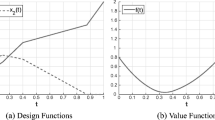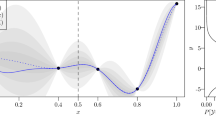Abstract
Collaborative optimization (CO), one of the multidisciplinary design optimization techniques, has been credited with guaranteeing disciplinary autonomy while maintaining interdisciplinary compatibility due to its bi-level optimization structure. However, a few difficulties caused by certain features of its architecture have been also reported. The architecture, with discipline-level optimizations nested in a system-level optimization, leads to considerably increased computational time. In addition, numerical difficulties such as the problem of slow convergence or unexpected nonlinearity of the compatibility constraint in the system-level optimization are known weaknesses of CO.
This paper proposes the use of an approximation model in place of the disciplinary optimization in the system-level optimization in order to relieve the aforementioned difficulties. The disciplinary optimization result, the optimal discrepancy function value, is modeled as a function of the interdisciplinary target variables, and design variables of the system level. However, since this approach is hindered by the peculiar form of the compatibility constraint, it is hard to exploit well-developed conventional approximation methods. In this paper, neural network classification is employed as a classifier to determine whether a design point is feasible or not. Kriging is also combined with the classification to make up for the weakness that the classification cannot estimate the degree of infeasibility.
In addition, for the purpose of enhancing the accuracy of the predicted optimum, this paper also employs two approximation management frameworks for single-objective and multi-objective optimization problem in the system-level optimization. The approximation is continuously updated using the information obtained from the optimization process. This can cut down the required number of disciplinary optimizations considerably and lead to a design (or Pareto set) near to the true optimum (or true Pareto set) of the system-level optimization.
Similar content being viewed by others
References
Alexandrov NM, Dennis Jr JE, Lewis RM, Torczon V (1998) A trust region framework for managing the use of approximation models in optimization. Struct Optim 15:16–23
Alexandrov NM, Lewis RM (1999) Comparative Properties of Collaborative Optimization and Other Approaches to MDO. Technical Report No. 99-24, ICASE, Institute for Computer Applications in Science and Engineering, NASA Langley Research Center, Hampton, VA
Alexandrov NM, Lewis RM (2000) Analytical and computational properties of distributed approaches to MDO. Proc. 8th AIAA/USAF/NASA/ISSMO Symp. on Multidisciplinary Analysis and Optimization (held in Long Beach, CA), pp 13–42, AIAA-2000-4718
Balling RJ, Sobieszczanski-Sobieski J (1995) An algorithm for solving the system-level problem in multilevel optimization. Struct Optim 9:168–177
Balling RJ, Sobieszczanski-Sobieski J (1996) Optimization of coupled systems: a critical overview of approaches. AIAA J 34(1):6–17
Booker AJ, Dennis Jr JE, Frank PD, Serafini DB, Torczon V, Trosset MW (1999) A rigorous framework for optimization of expensive functions by surrogates. Struct Optim 17:1–13
Braun RD (1996a) Collaborative optimization: an architecture for large-scale distributed design. Ph.D. Thesis, Stanford University
Braun RD, Moore AA, Kroo IM (1996b) Use of the collaborative optimization architecture for launch vehicle design. Proc. 6th AIAA/USAF/NASA/ISSMO Symp. on Multidisciplinary Analysis and Optimization, (held in Bellevue, Washington), pp 306–318, AIAA Paper No. 96-4018
Cressie NAC (1993) Statistics for spatial data. Revised Edition. Wiley, New York
DeMiguel A, Murray W (2000) An analysis of collaborative optimization methods. Proc. 6th AIAA/USAF/NASA/ISSMO Symp. on Multidisciplinary Analysis and Optimization, (held in Bellevue, Washington), AIAA-2000-4720
Dennis JE, Torczon Jr V (1997) Managing approximation models in optimization. In: Alexandrov N, Hussaini MY (eds) Multidisciplinary design optimization: state-of-the-art, pp 330–347, SIAM, Philadelphia, Also available as Technical Report 95-19, Department of Computational and Applied Mathematics, Rice University, Houston, Texas 77005-1892
Goldberg DE (1989) Genetic algorithms on search, optimization, and machine learning, Addison-Wesley, Reading, MA
Haykin S (1994) Neural networks, a comprehensive foundation. Macmillian College, New York
Johnson ME, Moore LM, Ylvisaker D (1990) Minmax and maximin distance design. J Stat Plann Inference 26:131–148
Kim GH (1994) Multicriteria structural optimization by genetic algorithm (in korean). Ph.D. Thesis, Department of Naval Architecture & Ocean Engineering, Seoul National University, Seoul, Korea
Kroo I, Altus S, Braun R, Gage P, Sobieski I (1994) Multidisciplinary optimization methods for aircraft preliminary design. Proc. 5th AIAA/USAF/NASA/ISSMO Symposium on Multidisciplinary Analysis and Optimization, (held in Panama City, FL), Vol. 1, pp 697–707, AIAA 94-4325
Kroo IM (1997) MDO for large-scale design. In: Alexandrov NM, Hussaini MY (eds) Multidisciplinary design optimization: state of the art, pp 22–44, SIAM, PA
Kroo IM, Manning VM (2000) Collaborative optimization: status and directions. Proc. 8th AIAA/USAF/NASA/ISSMO Symp. on Multidisciplinary Analysis and Optimization, (held in Long Beach, CA), AIAA-2000-4721
McAllister CD, Simpson TW, Yukish M (2000) Goal programming applications in multidisciplinary design optimization. Proc. 8th AIAA/USAF/NASA/ISSMO Symp. on Multidisciplinary Analysis and Optimization, held in Long Beach, CA), AIAA-2000-4717
Sobieski IP, Manning VM, Kroo IM (1998a) Response surface estimation and refinement in collaborative optimization. Proc. 7th AIAA/USAF/NASA/ISSMO Symp. on Multidisciplinary Analysis and Optimization, (held in St. Louis, Missouri), pp 359–370, AIAA 98-4753
Sobieski IP (1998b) Multidisciplinary design using collaborative optimization. Ph.D. Thesis, Department of Aeronautics and Astronautics, Stanford University
Sobieski IP, Kroo IM (2000) Collaborative optimization using response surface estimation. AIAA J 38(10):1931–1938
Simpson TW (1998a) A concept exploration method for product family design. Ph.D. Thesis, Department of Mechanical Engineering, Georgia Institute of Technology
Simpson TW (1998b) Spatial correlation metamodels for global approximation in structural design optimization. Proc. DETC98 (ASME Design Engineering Technical Conf. held Atlanta, GA)
Toropov VV (1989) Simulation approach to structural optimization. Struct Optim 1:37–46
Toropov V, van Keulen F, Markine V, de Boer H (1996) Refinements in the multi-point approximation method to reduce the effects of noisy structural responses. Proc. 6th AIAA/USAF/NASA/ISSMO Symposium on Multidisciplinary Analysis and Optimization (held in Bellevue, WA), Vol. 2, pp 941–951 AIAA-96-4087-CP
Trosset MW, Torczon V (1997) Numerical optimization using computer experiments. Technical Report 97-38, ICASE, NASA Langley Research Center, Hampton, VA
Yang YS, Jang BS, Yeun YS, Jung HS (2000) A framework for managing approximation models in place of expensive simulations in optimization. Proc. 2nd ASMO UK/ISSMO Conference on Engineering Design Optimization (held in Swansea, Wales, UK), pp 249–256
Yang YS, Jang BS, Yeun YS, Ruy WS (2002) Managing approximation models in multi-objective optimization. Struct Optim 24:141–156
Author information
Authors and Affiliations
Corresponding author
Rights and permissions
About this article
Cite this article
Jang, BS., Yang, YS., Jung, HS. et al. Managing approximation models in collaborative optimization. Struct Multidisc Optim 30, 11–26 (2005). https://doi.org/10.1007/s00158-004-0492-y
Received:
Revised:
Published:
Issue Date:
DOI: https://doi.org/10.1007/s00158-004-0492-y




